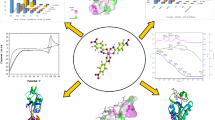Abstract
The kinetics and mechanism of the reaction of diaquacobinamide (Cbi(III)) with isoniazid (iso-nicotinoyl hydrazide (INH)) are studied. It is determined that the composition of the products depends on the ratio between the concentrations of the reactants. Adding excess INH to cobinamide results in the rapid formation of a stable complex of Cbi(III) with two isoniazid molecules. If the concentrations of isoniazid and cobinamide are close, or cobinamide is in excess, then a complex of Cbi(III) with one isoniazid molecule initially forms. There is then a fast inner-sphere electron transfer to yield an unstable complex of reduced Cbi(II) with hydrazyl radical (RN2H2)(Cbi(II)) that decomposes to form reduced cobinamide and the products of the oxidation of isoniazid: isonicotinamide, pyridine-4-carboxaldehyde, and isonicotinic acid (INA). It is concluded that with a 1000% excess of cobinamide, the main product of the oxidation of INH is INA.





Similar content being viewed by others
REFERENCES
Reference Guide for Emergency Doctor, Ed. by A. L. Vertkin (GEOTAR-MED, Moscow, 2001) [in Russian].
J. M. Marraffa, V. Cohen, and M. A. Howland, Am. J. Health Syst. Pharm. 69, 199 (2012).
S. Bradberry and A. Vale, Medicine 35, 562 (2007).
P. Preziosi, Curr. Drug. Metab. 8, 839 (2007).
P. Wang, Acta Pharm Sin. B 6, 384 (2016).
R. C. Watkins, E. L. Hambrick, G. Benjamin, and S. N. Chavda, J. Natl. Med. Assoc. 82, 57 (1990).
M. L. Sievers and R. N. Herrier, Am. J. Hosp. Pharm 32, 202 (1975).
W. P. Tai, H. Yue, and P. J. Hu, Adv. Ther. 25, 1085 (2008).
A. I. Scott and C. A. Roessner, Biochem. Soc. Trans. 30, 613 (2002).
K. E. Broderick et al., Exp. Biol. Med. 231, 641 (2006).
A. Chan et al., Clin. Toxicol. 48, 709 (2010).
D. S. Salnikov, P. N. Kucherenko, I. A. Dereven’kov, et al., Eur. J. Inorg. Chem., 852 (2014).
D. S. Salnikov, S. V. Makarov, R. van Eldik, et al., Eur. J. Inorg. Chem., 4123 (2014).
M. Brenner, S. Benavides, S. B. Mahon, et al., Clin. Toxicol. 52, 490 (2014).
J. Jiang, A. Chan, S. Ali, et al., Sci. Rep. 6, 20831 (2016).
K. E. Broderick, V. Singh, S. Zhuang, et al., J. Biol. Chem. 280, 8678 (2005).
S. O. Tumakov, I. A. Dereven’kov, D. S. Salnikov, and S. V. Makarov, Russ. J. Phys. Chem. A 91, 1839 (2017).
W. C. Blackledge, A. Griesel, S. B. Mahon, et al., Anal. Chem. 82, 4216 (2010).
I. A. Dereven’kov, D. S. Salnikov, S. V. Makarov, et al., J. Inorg. Biochem. 125, 32 (2013).
P. N. Kucherenko, D. S. Salnikov, Thu Thuy Bui, et al., Macroheterocycles 6, 262 (2013).
W. C. Blackledge, C. W. Blackledge, A. Griesel, et al., Anal. Chem. 82, 4216 (2010).
I. A. Dereven’kov, D. S. Salnikov, R. Silaghi-Dumitrescu, et al., Coord. Chem. Rev. 309, 68 (2016).
J. Dong, Y. Ren, S. Sun, et al., Dalton Trans. 46, 8377 (2017).
V. Bogdándi, G. Lente, and I. Fábián, RSC Adv. 5, 67500 (2015).
K. Johnsson and P. G. Schultz, J. Am. Chem. Soc. 116, 7425 (1994).
M. J. Hynes, Proc. R. Irish Acad., Sect. B: Biol., Geol. Chem. Sci. 89, 435 (1989).
B. K. Sinha and R. P. Mason, J. Drug. Metab. Toxicol. 5, 168 (2014).
I. Metushi, J. Uetrecht, and E. Phillips, Br. J. Clin. Pharmacol. 81, 1030 (2016).
L. V. Forbes et al., Biochem. Pharmacol. 84, 949 (2012).
ACKNOWLEDGMENTS
This work was supported by the Russian Science Foundation, project no. 14-23-00204 P. The authors thank researcher N. Pechnikova at the Laboratory of Gas Chromatography, Mass Spectrometry, and EPR Spectrometry, Shared Scientific Resource Center, Ivanovo State University of Chemistry and Technology, Ivanovo, Russia, for her help in analyzing the products of the oxidation of isoniazid via gas chromatography–mass spectrometry.
Author information
Authors and Affiliations
Corresponding author
Additional information
Translated by V. Glyanchenko
Rights and permissions
About this article
Cite this article
Tumakov, S.O., Dereven’kov, I.A., Sal’nikov, D.S. et al. Kinetics of the Reaction between Cobinamide and Isoniazid in Aqueous Solutions. Russ. J. Phys. Chem. 93, 265–270 (2019). https://doi.org/10.1134/S0036024419020274
Received:
Published:
Issue Date:
DOI: https://doi.org/10.1134/S0036024419020274




